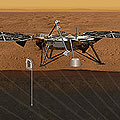 The InSight mission for planet Mars fills a longstanding gap in the scientific exploration of the solar system by performing, for the first time, an in-situ investigation of the interior of a truly Earthlike planet other than our own. InSight provides unique and critical information about the fundamental processes of terrestrial planet formation and evolution.
The InSight mission for planet Mars fills a longstanding gap in the scientific exploration of the solar system by performing, for the first time, an in-situ investigation of the interior of a truly Earthlike planet other than our own. InSight provides unique and critical information about the fundamental processes of terrestrial planet formation and evolution.
InSight's main objective is to improve our knowledge onto the earliest history of the processes that shaped Mars. To this end it is studying the size, thickness, density and overall structure of the planet's core, mantle, and crust. The InSight Lander has deployed three instruments on the surface of Mars to take the first-ever in-depth look at the planet's internal activity. The three instruments are:
- The SEIS instrument for measuring seismic waves of Martian earthquakes
- The HP3 instrument to quantify the heat flow from the planet's interior to its surface
- The RISE experiment for calculating the wobbly rotation of the planet
More information about InSight can be found here.
InSight was first pre-selected out of 28 submitted mission proposals along with two other proposals for a study (Phase A), which was conducted during 2011 and ended with the Concept Study Report in March 2012. In August 2012 NASA has selected InSight for its next Discovery Program. The Insight spacecraft was launched on May 5 2018, and landed on Mars six months later on November 26 2018.
Our Work
AEIL is responsible for the seismometer acquisition electronics, the power generation and an electronic box (SEIS-EBX) of the Seismic Experiment for Interior Structure (SEIS) instrument. In addition, AEIL is the system integrator of all other electronics inside the SEIS-EBX.
AEIL collaborates on the SEIS instrument with the following institutes:
- Centre National d'Etudes Spatiales (CNES), France: SEIS management and integration
- Institut de Physique du Globe de Paris (IPGP), France: Very Broad Band (VBB) seismometer sensor and feedback electronics development
- Imperial College (IC), UK: Short Period (SP) seismometer sensor and feedback electronics development
- Max Planck Institute for Solar System Research (MPS), Germany: Seismometer leveling system and driving electronics development
- Jet Propulsion Laboratory (JPL), USA: Meteorological sensor with electronics, wind and thermal shield and harness development. JPL is also responsible for the whole lander with associated equipment.
Currently, the SEIS instrument has been successfully deployed on Mars surface and it is recording Mars earthquakes.
